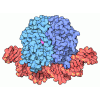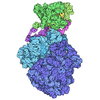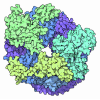+ Open data
Open data
- Basic information
Basic information
| Entry |  | |||||||||
|---|---|---|---|---|---|---|---|---|---|---|
| Title | Structure of Pol II-TC-NER-STK19 complex, composite map | |||||||||
 Map data Map data | composite map | |||||||||
 Sample Sample |
| |||||||||
 Keywords Keywords | Transcription-coupled DNA repair / TRANSCRIPTION | |||||||||
| Function / homology |  Function and homology information Function and homology informationRNA polymerase inhibitor activity / negative regulation of double-strand break repair via nonhomologous end joining / regulation of transcription-coupled nucleotide-excision repair / nucleotide-excision repair complex / positive regulation of single strand break repair / regulation of transcription elongation by RNA polymerase II / B-WICH complex / DNA protection / single strand break repair / positive regulation by virus of viral protein levels in host cell ...RNA polymerase inhibitor activity / negative regulation of double-strand break repair via nonhomologous end joining / regulation of transcription-coupled nucleotide-excision repair / nucleotide-excision repair complex / positive regulation of single strand break repair / regulation of transcription elongation by RNA polymerase II / B-WICH complex / DNA protection / single strand break repair / positive regulation by virus of viral protein levels in host cell / Formation of RNA Pol II elongation complex / Formation of the Early Elongation Complex / Transcriptional regulation by small RNAs / RNA Polymerase II Pre-transcription Events / TP53 Regulates Transcription of DNA Repair Genes / FGFR2 alternative splicing / RNA polymerase II transcribes snRNA genes / mRNA Capping / mRNA Splicing - Minor Pathway / Processing of Capped Intron-Containing Pre-mRNA / RNA Polymerase II Promoter Escape / RNA Polymerase II Transcription Pre-Initiation And Promoter Opening / RNA Polymerase II Transcription Initiation / RNA Polymerase II Transcription Elongation / RNA Polymerase II Transcription Initiation And Promoter Clearance / RNA Pol II CTD phosphorylation and interaction with CE / Estrogen-dependent gene expression / Formation of TC-NER Pre-Incision Complex / Dual incision in TC-NER / Gap-filling DNA repair synthesis and ligation in TC-NER / mRNA Splicing - Major Pathway / chromatin-protein adaptor activity / response to superoxide / double-strand break repair via classical nonhomologous end joining / spindle assembly involved in female meiosis / photoreceptor cell maintenance / ATP-dependent chromatin remodeler activity / epigenetic programming in the zygotic pronuclei / Cul4-RING E3 ubiquitin ligase complex / nuclear lumen / UV-damage excision repair / positive regulation of Ras protein signal transduction / response to UV-B / RNA polymerase binding / positive regulation of DNA-templated transcription, elongation / biological process involved in interaction with symbiont / regulation of mitotic cell cycle phase transition / positive regulation of transcription by RNA polymerase III / WD40-repeat domain binding / Cul4A-RING E3 ubiquitin ligase complex / ATP-dependent DNA damage sensor activity / Cul4B-RING E3 ubiquitin ligase complex / ubiquitin ligase complex scaffold activity / : / negative regulation of reproductive process / negative regulation of developmental process / positive regulation of transcription by RNA polymerase I / RNA polymerase II complex binding / cullin family protein binding / maintenance of transcriptional fidelity during transcription elongation by RNA polymerase II / protein tyrosine kinase activator activity / viral release from host cell / RNA Polymerase I Transcription Initiation / site of DNA damage / : / : / : / pyrimidine dimer repair / : / : / response to X-ray / transcription by RNA polymerase III / : / ATP-dependent activity, acting on DNA / ectopic germ cell programmed cell death / positive regulation of transcription initiation by RNA polymerase II / positive regulation of viral genome replication / positive regulation of double-strand break repair via homologous recombination / RNA polymerase I complex / transcription elongation by RNA polymerase I / RNA polymerase III complex / proteasomal protein catabolic process / transcription by RNA polymerase I / transcription-coupled nucleotide-excision repair / response to UV / RNA polymerase II, core complex / tRNA transcription by RNA polymerase III / protein autoubiquitination / JNK cascade / neurogenesis / positive regulation of gluconeogenesis / DNA-directed RNA polymerase complex / positive regulation of DNA repair / DNA damage checkpoint signaling / transcription elongation factor complex / ERCC6 (CSB) and EHMT2 (G9a) positively regulate rRNA expression / regulation of DNA-templated transcription elongation / Recognition of DNA damage by PCNA-containing replication complex / response to gamma radiation / DNA Damage Recognition in GG-NER Similarity search - Function | |||||||||
| Biological species |  Homo sapiens (human) / Homo sapiens (human) /  | |||||||||
| Method | single particle reconstruction / cryo EM / Resolution: 3.4 Å | |||||||||
 Authors Authors | Lee S-H / Sixma TK | |||||||||
| Funding support |  Netherlands, 2 items Netherlands, 2 items
| |||||||||
 Citation Citation |  Journal: Mol Cell / Year: 2024 Journal: Mol Cell / Year: 2024Title: STK19 drives transcription-coupled repair by stimulating repair complex stability, RNA Pol II ubiquitylation, and TFIIH recruitment. Authors: Anisha R Ramadhin / Shun-Hsiao Lee / Di Zhou / Anita Salmazo / Camila Gonzalo-Hansen / Marjolein van Sluis / Cindy M A Blom / Roel C Janssens / Anja Raams / Dick Dekkers / Karel Bezstarosti ...Authors: Anisha R Ramadhin / Shun-Hsiao Lee / Di Zhou / Anita Salmazo / Camila Gonzalo-Hansen / Marjolein van Sluis / Cindy M A Blom / Roel C Janssens / Anja Raams / Dick Dekkers / Karel Bezstarosti / Dea Slade / Wim Vermeulen / Alex Pines / Jeroen A A Demmers / Carrie Bernecky / Titia K Sixma / Jurgen A Marteijn /   Abstract: Transcription-coupled nucleotide excision repair (TC-NER) efficiently eliminates DNA damage that impedes gene transcription by RNA polymerase II (RNA Pol II). TC-NER is initiated by the recognition ...Transcription-coupled nucleotide excision repair (TC-NER) efficiently eliminates DNA damage that impedes gene transcription by RNA polymerase II (RNA Pol II). TC-NER is initiated by the recognition of lesion-stalled RNA Pol II by CSB, which recruits the CRL4 ubiquitin ligase and UVSSA. RNA Pol II ubiquitylation at RPB1-K1268 by CRL4 serves as a critical TC-NER checkpoint, governing RNA Pol II stability and initiating DNA damage excision by TFIIH recruitment. However, the precise regulatory mechanisms of CRL4 activity and TFIIH recruitment remain elusive. Here, we reveal human serine/threonine-protein kinase 19 (STK19) as a TC-NER factor, which is essential for correct DNA damage removal and subsequent transcription restart. Cryogenic electron microscopy (cryo-EM) studies demonstrate that STK19 is an integral part of the RNA Pol II-TC-NER complex, bridging CSA, UVSSA, RNA Pol II, and downstream DNA. STK19 stimulates TC-NER complex stability and CRL4 activity, resulting in efficient RNA Pol II ubiquitylation and correct UVSSA and TFIIH binding. These findings underscore the crucial role of STK19 as a core TC-NER component. | |||||||||
| History |
|
- Structure visualization
Structure visualization
| Supplemental images |
|---|
- Downloads & links
Downloads & links
-EMDB archive
| Map data |  emd_50325.map.gz emd_50325.map.gz | 187.4 MB |  EMDB map data format EMDB map data format | |
|---|---|---|---|---|
| Header (meta data) |  emd-50325-v30.xml emd-50325-v30.xml emd-50325.xml emd-50325.xml | 48.5 KB 48.5 KB | Display Display |  EMDB header EMDB header |
| Images |  emd_50325.png emd_50325.png | 44.6 KB | ||
| Filedesc metadata |  emd-50325.cif.gz emd-50325.cif.gz | 14.4 KB | ||
| Archive directory |  http://ftp.pdbj.org/pub/emdb/structures/EMD-50325 http://ftp.pdbj.org/pub/emdb/structures/EMD-50325 ftp://ftp.pdbj.org/pub/emdb/structures/EMD-50325 ftp://ftp.pdbj.org/pub/emdb/structures/EMD-50325 | HTTPS FTP |
-Validation report
| Summary document |  emd_50325_validation.pdf.gz emd_50325_validation.pdf.gz | 377.6 KB | Display |  EMDB validaton report EMDB validaton report |
|---|---|---|---|---|
| Full document |  emd_50325_full_validation.pdf.gz emd_50325_full_validation.pdf.gz | 377.3 KB | Display | |
| Data in XML |  emd_50325_validation.xml.gz emd_50325_validation.xml.gz | 7.4 KB | Display | |
| Data in CIF |  emd_50325_validation.cif.gz emd_50325_validation.cif.gz | 8.7 KB | Display | |
| Arichive directory |  https://ftp.pdbj.org/pub/emdb/validation_reports/EMD-50325 https://ftp.pdbj.org/pub/emdb/validation_reports/EMD-50325 ftp://ftp.pdbj.org/pub/emdb/validation_reports/EMD-50325 ftp://ftp.pdbj.org/pub/emdb/validation_reports/EMD-50325 | HTTPS FTP |
-Related structure data
| Related structure data |  9fd2MC C: citing same article ( M: atomic model generated by this map |
|---|---|
| Similar structure data | Similarity search - Function & homology  F&H Search F&H Search |
- Links
Links
| EMDB pages |  EMDB (EBI/PDBe) / EMDB (EBI/PDBe) /  EMDataResource EMDataResource |
|---|---|
| Related items in Molecule of the Month |
- Map
Map
| File |  Download / File: emd_50325.map.gz / Format: CCP4 / Size: 244.1 MB / Type: IMAGE STORED AS FLOATING POINT NUMBER (4 BYTES) Download / File: emd_50325.map.gz / Format: CCP4 / Size: 244.1 MB / Type: IMAGE STORED AS FLOATING POINT NUMBER (4 BYTES) | ||||||||||||||||||||||||||||||||||||
|---|---|---|---|---|---|---|---|---|---|---|---|---|---|---|---|---|---|---|---|---|---|---|---|---|---|---|---|---|---|---|---|---|---|---|---|---|---|
| Annotation | composite map | ||||||||||||||||||||||||||||||||||||
| Projections & slices | Image control
Images are generated by Spider. | ||||||||||||||||||||||||||||||||||||
| Voxel size | X=Y=Z: 1.06 Å | ||||||||||||||||||||||||||||||||||||
| Density |
| ||||||||||||||||||||||||||||||||||||
| Symmetry | Space group: 1 | ||||||||||||||||||||||||||||||||||||
| Details | EMDB XML:
|
-Supplemental data
- Sample components
Sample components
+Entire : Ternary complex of Pol II-TC-NER-STK19, composite map
+Supramolecule #1: Ternary complex of Pol II-TC-NER-STK19, composite map
+Macromolecule #1: DNA-directed RNA polymerase subunit
+Macromolecule #2: DNA-directed RNA polymerase subunit beta
+Macromolecule #3: DNA-directed RNA polymerase II subunit RPB3
+Macromolecule #4: RNA polymerase II subunit D
+Macromolecule #5: DNA-directed RNA polymerase II subunit E
+Macromolecule #6: DNA-directed RNA polymerases I, II, and III subunit RPABC2
+Macromolecule #7: DNA-directed RNA polymerase subunit
+Macromolecule #8: DNA-directed RNA polymerases I, II, and III subunit RPABC3
+Macromolecule #9: DNA-directed RNA polymerase II subunit RPB9
+Macromolecule #10: DNA-directed RNA polymerases I, II, and III subunit RPABC5
+Macromolecule #11: DNA-directed RNA polymerase II subunit RPB11-a
+Macromolecule #12: RNA polymerase II, I and III subunit K
+Macromolecule #13: Transcription elongation factor 1 homolog
+Macromolecule #17: DNA excision repair protein ERCC-8
+Macromolecule #18: DNA damage-binding protein 1
+Macromolecule #19: DET1- and DDB1-associated protein 1
+Macromolecule #20: Inactive serine/threonine-protein kinase 19
+Macromolecule #21: DNA excision repair protein ERCC-6
+Macromolecule #22: UV-stimulated scaffold protein A
+Macromolecule #14: Non-template DNA
+Macromolecule #16: Template DNA
+Macromolecule #15: RNA
+Macromolecule #23: ZINC ION
+Macromolecule #24: MAGNESIUM ION
-Experimental details
-Structure determination
| Method | cryo EM |
|---|---|
 Processing Processing | single particle reconstruction |
| Aggregation state | particle |
- Sample preparation
Sample preparation
| Concentration | 0.15 mg/mL | ||||||||||||||||||
|---|---|---|---|---|---|---|---|---|---|---|---|---|---|---|---|---|---|---|---|
| Buffer | pH: 7.5 Component:
| ||||||||||||||||||
| Grid | Model: Quantifoil R1.2/1.3 / Material: COPPER / Mesh: 300 / Support film - Material: CARBON / Support film - topology: HOLEY | ||||||||||||||||||
| Vitrification | Cryogen name: ETHANE / Chamber humidity: 100 % / Chamber temperature: 277 K / Instrument: FEI VITROBOT MARK IV | ||||||||||||||||||
| Details | The final concentration of Pol II is around 0.15 mg/ml. The other components were added in different molar ratio. This sample was glutaraldehyde crosslinked. |
- Electron microscopy
Electron microscopy
| Microscope | FEI TITAN KRIOS |
|---|---|
| Specialist optics | Energy filter - Slit width: 20 eV |
| Details | Collected on Krios 1 at Netherlands Center for Electron Nanoscopy (NeCEN) |
| Image recording | Film or detector model: GATAN K3 BIOQUANTUM (6k x 4k) / Number grids imaged: 2 / Number real images: 13029 / Average exposure time: 3.43 sec. / Average electron dose: 50.0 e/Å2 Details: Two datasets were collected from the same sample using the same parameters. |
| Electron beam | Acceleration voltage: 300 kV / Electron source:  FIELD EMISSION GUN FIELD EMISSION GUN |
| Electron optics | C2 aperture diameter: 50.0 µm / Illumination mode: FLOOD BEAM / Imaging mode: BRIGHT FIELD / Cs: 2.7 mm / Nominal defocus max: 2.2 µm / Nominal defocus min: 0.8 µm / Nominal magnification: 81000 |
| Sample stage | Specimen holder model: FEI TITAN KRIOS AUTOGRID HOLDER / Cooling holder cryogen: NITROGEN |
| Experimental equipment |  Model: Titan Krios / Image courtesy: FEI Company |
 Movie
Movie Controller
Controller




















 X (Sec.)
X (Sec.) Y (Row.)
Y (Row.) Z (Col.)
Z (Col.)






















